2ND TO 18TH FEBRUARY 2005.
Following our wedding on 29th January, we had arranged to visit New Zealand for our honeymoon, mainly to walk some of their long distance paths (or tramps, as they are known). Although not specifically a birding trip, it was inevitable that a decent variety of birds would be seen during our travels. New Zealand does not have a large bird list (the national day list record is only about 75 species), but does have some very unusual specialities, and a number of flightless birds. There are also a lot of European introductions.
On arrival in Auckland (2nd February), after flying from Heathrow via Los Angeles, we had time to stroll through parkland between terminals before our internal flight to Blenheim, at the north end of South Island. We were quickly discovering birds. Introduced species such as House Sparrow, Starling, Goldfinch, Myna and Barbary Dove mixed with native species such as Welcome Swallow (NZ’s only hirundine), Red Billed and Black Backed (or Kelp) Gull.
After a pleasant flight, we arrived at Blenheim, where our first Spur Winged Plovers were present on the airfield. As we travelled by minibus through the famous Marlborough Vineyards, a Song Thrush and more Spur Winged Plovers were seen. Our destination was a resort called Punga Cove on an inlet of the Marlborough Sounds, accessed by water taxi from the small town of Picton. Whilst waiting for the boat, Blackbird, Mallard, Grey Duck and Black Billed Gull were seen. We had already seen all three species of gull likely to be present in NZ.
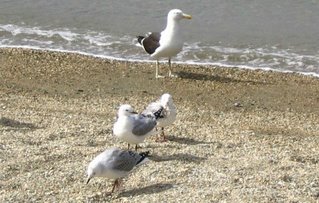
From the small water taxi, new species were rapidly added. Pied and Variable Oystercatchers, Spotted and Pied Shag, our Cormorant, Australasian Gannet, White Fronted Tern, Australasian Harrier (a very common bird), Fluttering Shearwater and finally, as we approached the resort, an Arctic Skua.
From the jetty, our friendly ferryman pointed out a Stingray a few feet away, very impressive. The resort was on a wooded hillside, and we had a stunning balcony view over the bay from our lodge. A large brown bird, like a cross between a water rail and a chicken was wandering around a few yards away. It was our first flightless bird, a Weka.

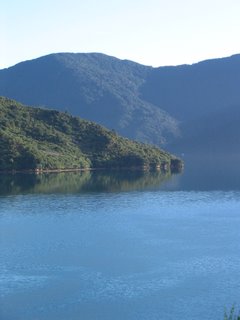
The following morning (3rd), slightly jet lagged, we decided to have a gentle stroll through the sub tropical rainforest that surrounded us, to the next resort, Endeavour, about 7 miles away. This is part of the popular Queen Charlotte Track.
The noise from the cicadas was quite intrusive to start with, but we soon got used to it. In the warm sunshine (approx 25C), many small birds were soon flitting around. Flocks of Silvereye,with a Siskin-like call were abundant, Tui (shown),
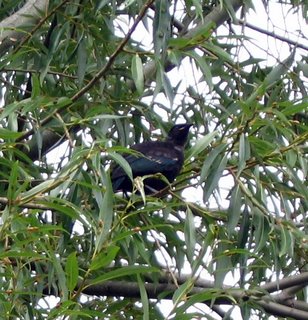
with a Nightingale-like song and the bulky New Zealand Pigeon (a greenish version of our Wood Pigeon).

We were most impressed with Fantails, looking a bit like a cross between a Long Tailed Tit and a Dartford Warbler. They dance around on branches, tails spread wide. Apparently they use the tails as radars, helping the birds to locate the flies they feed on. Both Pied and Black varieties were seen.
Bellbirds were seen, and a thin reedy song was heard from nearby. It reminded us of an old man whistling. Eventually we found the source, a Grey Warbler, an abundant bird, and NZ’s only warbler. Chaffinches were also seen. Arriving at Endeavour, we had a couple of hours to wait for the boat back across the bay to Punga, which was spent sitting in the sun sampling the local beers and watching more Australasian Harriers and many of the small birds already seen.
The 4th was cooler and cloudy, which was useful as we had a fair bit of walking to do, and an “Eco tour” boat to catch in the afternoon.
We soon climbed away from the shoreline, through a small area of scrub where Linnets, Greenfinches and Tom Tits were seen, and into pine forest, where Brown Creepers were found. Soon a familiar “sewing machine” call was heard overhead. Decent views of the birds concerned revealed Mealy Redpoll, which turned out to be one of the most common birds in NZ !
After four and half hours brisk walking, we arrived at the Bay of Many Coves Resort, with a few minutes to spare before our eco tour collected us, just enough time the see more Weka, a local Kingfisher, greener than ours; and the uncommon Reef Heron, amongst more Pied and Spotted Shags.
The main aim of the boat trip was to look for Hector’s Dolphins, the world smallest (4ft) and rarest dolphin. We were lucky enough to have close views of a group of about ten of these lovely creatures. Soon afterwards, we passed a small bird resting on the water, I absent-mindedly thought Guillemot, until I pulled myself together, remembering there are none there, it was a Little Blue Penguin!
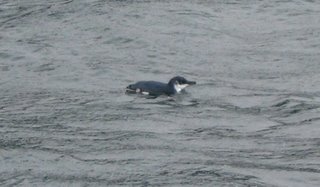
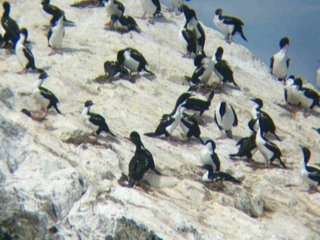

The boat then took us to see one of the few nesting colonies of King Shag, apparently the world’s rarest cormorant. 30-40 birds were present on “White Rock”, so called because of the guano. We passed through a very large flock of Fluttering Shearwaters, and a single Fairy Prion was seen. The boat stopped briefly at Motorua Island, and we had just enough time to visit a water hole, where we were lucky enough to see a family of Saddlebacks, one of the worlds rarest birds, and now only found on offshore, predator free islands. A NZ Robin was also present. We were dropped back at Bay of Many Coves Resort, and used the hour before our boat home to sample some more local beers.
On the 5th we retraced our steps to Endeavour and carried on further to Resolution, to catch a water taxi home (15 miles in 30C heat, I thought this was a holiday!). The only new species was the first of many White Faced Herons. That evening, we heard a Morepork (similar to a Tawny Owl) very close to our lodge.
We now packed our belongings and spent most of the 6th travelling to Queenstown in the SW of South Island. A water taxi (with a detour to see a fur seal)
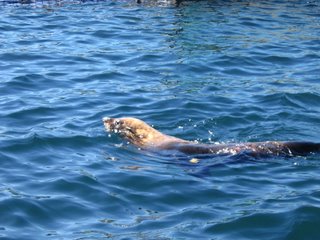
and three flights later, we were able to sit on the balcony of our B and B “5 Star Lane”, a superb modern building with splendid lake and mountain views, run by a friendly and efficient South African couple, Ray and Merlin Sansom. After home made scones and tea, we walked into town and found Dunnock and Yellowhammers in gardens nearby, and Great Crested Grebes, Grey Duck (shown) and New Zealand Scaup on Lake Wakatipo.
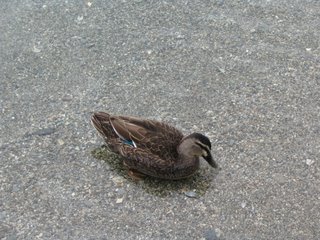
After spending the 7th resting and being tourists around Queenstown, we packed up again on the 8th, a warm sunny morning, and caught a bus for an hour to the beginning of one of NZs best known tramps, the Routeburn. This walk is 28 miles, beginning and ending in forest, and climbing through alpine scenery higher than anywhere in the UK. We had booked to spend 3 nights staying in mountain huts en route, and would have to carry approx 25lb each (food and cooking utensils, clothes, sleeping bags, and a small telescope!) From the bus we saw Black Swans and Australian Magpies (a normal corvoid shape, unlike our magpie). We started the walk amongst forest and soon were surrounded by the charismatic Riflemen, NZs smallest bird, similar to a Goldcrest, but moving more like a Treecreeper. We climbed alongside a spectacular gorge and eventually emerged at Routeburn Flats Hut, where a river meandered through meadows surrounded by mountains of over 6000ft, some of which held small glaciers.

After claiming our bunks, and trying out the “long drop” lavatories, we strolled through the forest adjacent to the hut and found a Yellow Crowned Parakeet, which we tracked down by its harsh call. Almost immediately we encountered a small flock of Yellowheads, a declining passerine species. Delighted with these sighting, we headed back as a New Zealand Falcon flew low over the treetops. This rare species is similar to a small brownish Peregrine, and we had another sighting that evening, 30 yards from us as we studied pictures of it in our Fieldguide.
After a reasonable night in our dormitory, we set off on the 9th for a long climb over the Harris Saddle in cooler, drizzly weather. As we climbed above 3000ft, the lush forest abruptly gave way to Alpine plants, and a bleaker landscape. The only birds for a while were Dunnocks, Yellowhammers and Mealy Redpoll, until we heard a harsh cry, not unlike a Chough. We immediately looked up to see three Keas flying in front of a cliff face. The world’s only alpine parrot is common in these surroundings and was one of the most eagerly anticipated birds of the trip. A long and slippery descent brought us wearily to the McKenzie Hut, next to a beautiful lake and surrounded by stunning mountain scenery.

With rain and high winds forecast on the 10th, after passing spectacular waterfalls we briskly walked to the next destination, the Howden Hut by lunchtime, and in the afternoon we explored local forest, examining the flowers and mosses that abound in them.
After another exciting rehydrated meal, it rained all night and into the morning, and we lingered as long as possible after breakfast on the 11th, before braving the elements for 90 minute walk to the road at the Divide to catch a bus to Milford Sound, a world famous fiord where we had booked a boat trip. When our bus eventually arrived, we were cold and wet, and were somewhat dismayed to discover that we were the only walkers with the remaining passengers being well dressed American and Japanese tourists!
Milford Sound in torrential rain was amazing, with waterfalls spontaneously spilling over sheer drops.
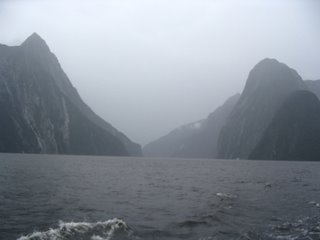
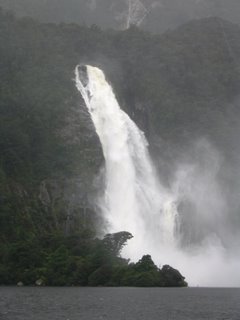
Mitre Peak, over 5000ft high was hazily visible, dropping nearly vertically to the sea. We were very glad of the unlimited tea supplies to warm us up. Wildlife was not abundant, but more gulls, White Fronted Terns, Fur Seals, and a pod of about ten Bottlenosed Dolphins were seen. The bus then took us to the small modern town of Te Anau, with the birding highlight being Paradise Shelduck on a roadside pool.
Rarely has a shower and a good meal been so welcome after 3 nights in huts with no showers and basic provisions.
The 12th was dry, though the mountains were in mist, and after stocking up with food, we set off to walk the Kepler Track, 39 miles in 3 days, again with heavy packs.
The walk started by taking us through a bird collection, where a couple of captive Takahe were present. These Shelduck sized flightless rails were thought extinct from 1900 to 1948, until rediscovered high in mountains near Te Anau. Access to an entire mountain range the size of about a third of Wales is forbidden, except for a few researchers, to protect habitat for this and other threatened species.
As we left the collection, we found one of the highlights of the trip, a Shining Cuckoo. The closest European bird for size and behaviour would probably be a Wryneck, but with a metallic green back, and a Barred Warblerish pattern on the front. Stunning!

We walked for six miles around the head of Lake Te Anau, and scrubby bushland gave way to more forest.


No additional species were seen, but a lot more Mealy Redpoll everywhere, and more Yellow Crowned Parakeets were seen high in treetops. We eventually began climbing, and just above 3000ft, we entered the alpine zone in mist. The tree line was very sudden everywhere we went, literally a few yards of transition only, from thick forest to open mountainside. We soon reached the Luxmoore Hut, at about the height of Snowdon, where another interesting rehydrated meal was “enjoyed”.
The 13th dawned bright and clear, and the superb view was enjoyed, as were close up views of 3 Kea on the balcony of the hut, before breakfast.
As we climbed away from the hut, a Rock Wren was seen briefly. The group of Kea were waiting for us a bit further up, and posed for photographs with the stunning Murchison Mountains behind them

The rest of the day, over Mt Luxmoore (4829ft), and a long alpine ridge, was brilliant in the sunshine, but apart from displaying Keas (think of overexcited Chough or Raven tumbling and calling), birdless.

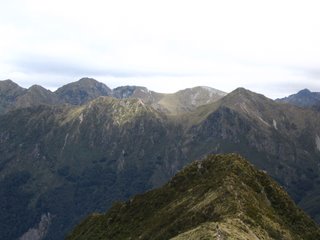
We dropped back down into forest and stayed the night in our last hut, the Iris Burn. The warden told us to listen for Brown Kiwi in the long grass overnight, and played us a recording of the calls. Torrential rain deterred us, however. Waking in the night, we clearly heard a male calling outside (unless the warden was standing outside in the rain with his CD player!)
Our plan for the 14th was straightforward, a 15mile walk down the valley, to catch the bus back to Te Anau. Luckily the rain stopped as we breakfasted, and we enjoyed our walk, although we didn’t find rare Blue Duck, as hoped. A brief detour to a small lake brought us our first NZ Pipit, a typical example of its family.
After another night in Te Anau, we caught an Intercity bus on the 15th down through mainly agricultural land to Invercargill on the south coast. As we travelled, more birds were seen, including Skylarks, several more Australasian Harriers, a Pukeko (aka Purple Swamp Hen), and surprisingly, a male Cirl Bunting, sat on wires at eye-level, a few feet away.
From Invercargill, we caught a small plane for the short flight across to our last destination, Stewart Island. There is only one small township on the Island, Oban or Half-Moon Bay. We were taken from the runway by minibus to the terminal shed (building is too grand a description), which is on the quayside, and doubles as the island Post Office. We were staying about 5 minutes walk away, but our friendly host, Ernie collected us and drove us around most of the islands roads. This took about 20 minutes!
Ernie has a keen interest in birds, and feeders were dotted about the garden. A male Tui was often seen coming to drink, and 2 Kaka, the forest equivalent of the Kea, were also hanging around the garden.
We walked through the township, around the bay, passing Variable Oystercatchers with a couple of chicks.
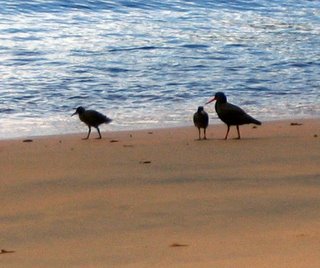
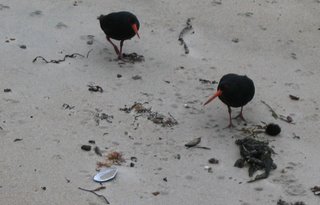
A large number of seabirds were visible distantly, so we decided to walk out to the headland at Akers Point, about a mile away, to get better views. There was a good selection, with Stewart Island Shags (pied and bronze phase) flying to and from a small island, White and Black Fronted Terns, hundreds of Sooty Shearwaters, and at least thirty of both Shy and Buller’s Mollymawks.

These are Gannet sized albatrosses, and very impressive. A Brown Skua passed, and a Little Blue Penguin sat on the sea, dived and disappeared!
An early start on the 16th was necessary, as we had booked an all day “eco tour” to Ulva Island, a small predator free island about a mile offshore. Our guide, Furhana, studied in Aberystwyth, and specialises in showing the whole range of flora and fauna on Ulva. Most of the birds were now very familiar to us, but Red Crowned Parakeets were new to us. The island has rat traps every 100 metres in a grid pattern across it. Periodically, a sterile rat is released, and if it is not trapped within a few days, more traps are laid. The Dept Of Conservation, who are heavily involved in all the areas we visited, are determined to keep predators off the island, as there are significant numbers of Saddleback and Yellowhead, both endangered species. We saw several of both species. Furhana gave us a lot of information on the trees and flowers present and showed us many of NZs 180 fern species. The island is one of the best preserved primeaval forests anywhere in the world, and hasn’t changed significantly in millions of years. We also found kiwi feathers and holes where one had been hunting recently. A memorable day.
The morning of the 17th was showery, so a leisurely wander around Oban kept us dry. With improving weather, we hired a glass bottomed water taxi for the afternoon, and were taken to see green-lipped mussel beds. More Mollymawks flew close by
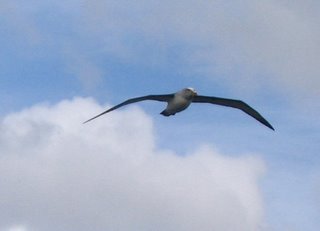
, and our captain pointed out 2 Yellow Eyed Penguins. We also visited a salmon farm, where Stewart Island Shags loitered for scraps.

Back on Stewart Island, Gill returned to our lodge, whilst I did more seawatching from the bay. The large Mollymawk flock were resting on the water again, and Sooty Shearwaters gave far better views than I’ve had in Britain. I was about to head to the only pub on the island, when I noticed a bird towering above the resting Mollymawks. It was a Wandering Albatross, and it soon took off and flew around the bay, giving excellent views. It was an amazing sight, and one of my birding highlights.

Sadly, we had to set off home on the 18th, but had time between flights in Invercargill to walk along a riverbank, where Royal Spoonbills were glimpsed flying away. Good numbers of Spur Winged Plovers and Pied Stilts (familiar as Black Winged Stilts) were seen
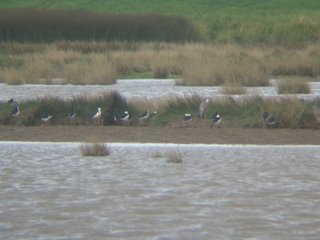
, and the last new NZ bird, Little Black Shag flew over.
During a thrilling 7 hours wait in Los Angeles airport (on our 2nd 18th Feb due to crossing the date line), American Crow and American Herring Gull were seen, but were poor fare after what we had left behind.
New Zealand is a superb place for a holiday, and we only scratched the surface of the birding possibilities. Wildlife/ eco tourism is big, and the infrastructure of transport and accommodation making travelling easy. The locals were very welcoming and nothing was too much trouble for those we dealt with. The weather was decent, and the local food and wine excellent. A fantastic holiday, and hopefully not our last visit.
 From the small water taxi, new species were rapidly added. Pied and Variable Oystercatchers, Spotted and Pied Shag, our Cormorant, Australasian Gannet, White Fronted Tern, Australasian Harrier (a very common bird), Fluttering Shearwater and finally, as we approached the resort, an Arctic Skua.
From the jetty, our friendly ferryman pointed out a Stingray a few feet away, very impressive. The resort was on a wooded hillside, and we had a stunning balcony view over the bay from our lodge. A large brown bird, like a cross between a water rail and a chicken was wandering around a few yards away. It was our first flightless bird, a Weka.
From the small water taxi, new species were rapidly added. Pied and Variable Oystercatchers, Spotted and Pied Shag, our Cormorant, Australasian Gannet, White Fronted Tern, Australasian Harrier (a very common bird), Fluttering Shearwater and finally, as we approached the resort, an Arctic Skua.
From the jetty, our friendly ferryman pointed out a Stingray a few feet away, very impressive. The resort was on a wooded hillside, and we had a stunning balcony view over the bay from our lodge. A large brown bird, like a cross between a water rail and a chicken was wandering around a few yards away. It was our first flightless bird, a Weka.

 The following morning (3rd), slightly jet lagged, we decided to have a gentle stroll through the sub tropical rainforest that surrounded us, to the next resort, Endeavour, about 7 miles away. This is part of the popular Queen Charlotte Track.
The noise from the cicadas was quite intrusive to start with, but we soon got used to it. In the warm sunshine (approx 25C), many small birds were soon flitting around. Flocks of Silvereye,with a Siskin-like call were abundant, Tui (shown),
The following morning (3rd), slightly jet lagged, we decided to have a gentle stroll through the sub tropical rainforest that surrounded us, to the next resort, Endeavour, about 7 miles away. This is part of the popular Queen Charlotte Track.
The noise from the cicadas was quite intrusive to start with, but we soon got used to it. In the warm sunshine (approx 25C), many small birds were soon flitting around. Flocks of Silvereye,with a Siskin-like call were abundant, Tui (shown), with a Nightingale-like song and the bulky New Zealand Pigeon (a greenish version of our Wood Pigeon).
with a Nightingale-like song and the bulky New Zealand Pigeon (a greenish version of our Wood Pigeon).
 We were most impressed with Fantails, looking a bit like a cross between a Long Tailed Tit and a Dartford Warbler. They dance around on branches, tails spread wide. Apparently they use the tails as radars, helping the birds to locate the flies they feed on. Both Pied and Black varieties were seen.
Bellbirds were seen, and a thin reedy song was heard from nearby. It reminded us of an old man whistling. Eventually we found the source, a Grey Warbler, an abundant bird, and NZ’s only warbler. Chaffinches were also seen. Arriving at Endeavour, we had a couple of hours to wait for the boat back across the bay to Punga, which was spent sitting in the sun sampling the local beers and watching more Australasian Harriers and many of the small birds already seen.
The 4th was cooler and cloudy, which was useful as we had a fair bit of walking to do, and an “Eco tour” boat to catch in the afternoon.
We soon climbed away from the shoreline, through a small area of scrub where Linnets, Greenfinches and Tom Tits were seen, and into pine forest, where Brown Creepers were found. Soon a familiar “sewing machine” call was heard overhead. Decent views of the birds concerned revealed Mealy Redpoll, which turned out to be one of the most common birds in NZ !
After four and half hours brisk walking, we arrived at the Bay of Many Coves Resort, with a few minutes to spare before our eco tour collected us, just enough time the see more Weka, a local Kingfisher, greener than ours; and the uncommon Reef Heron, amongst more Pied and Spotted Shags.
The main aim of the boat trip was to look for Hector’s Dolphins, the world smallest (4ft) and rarest dolphin. We were lucky enough to have close views of a group of about ten of these lovely creatures. Soon afterwards, we passed a small bird resting on the water, I absent-mindedly thought Guillemot, until I pulled myself together, remembering there are none there, it was a Little Blue Penguin!
We were most impressed with Fantails, looking a bit like a cross between a Long Tailed Tit and a Dartford Warbler. They dance around on branches, tails spread wide. Apparently they use the tails as radars, helping the birds to locate the flies they feed on. Both Pied and Black varieties were seen.
Bellbirds were seen, and a thin reedy song was heard from nearby. It reminded us of an old man whistling. Eventually we found the source, a Grey Warbler, an abundant bird, and NZ’s only warbler. Chaffinches were also seen. Arriving at Endeavour, we had a couple of hours to wait for the boat back across the bay to Punga, which was spent sitting in the sun sampling the local beers and watching more Australasian Harriers and many of the small birds already seen.
The 4th was cooler and cloudy, which was useful as we had a fair bit of walking to do, and an “Eco tour” boat to catch in the afternoon.
We soon climbed away from the shoreline, through a small area of scrub where Linnets, Greenfinches and Tom Tits were seen, and into pine forest, where Brown Creepers were found. Soon a familiar “sewing machine” call was heard overhead. Decent views of the birds concerned revealed Mealy Redpoll, which turned out to be one of the most common birds in NZ !
After four and half hours brisk walking, we arrived at the Bay of Many Coves Resort, with a few minutes to spare before our eco tour collected us, just enough time the see more Weka, a local Kingfisher, greener than ours; and the uncommon Reef Heron, amongst more Pied and Spotted Shags.
The main aim of the boat trip was to look for Hector’s Dolphins, the world smallest (4ft) and rarest dolphin. We were lucky enough to have close views of a group of about ten of these lovely creatures. Soon afterwards, we passed a small bird resting on the water, I absent-mindedly thought Guillemot, until I pulled myself together, remembering there are none there, it was a Little Blue Penguin!


 The boat then took us to see one of the few nesting colonies of King Shag, apparently the world’s rarest cormorant. 30-40 birds were present on “White Rock”, so called because of the guano. We passed through a very large flock of Fluttering Shearwaters, and a single Fairy Prion was seen. The boat stopped briefly at Motorua Island, and we had just enough time to visit a water hole, where we were lucky enough to see a family of Saddlebacks, one of the worlds rarest birds, and now only found on offshore, predator free islands. A NZ Robin was also present. We were dropped back at Bay of Many Coves Resort, and used the hour before our boat home to sample some more local beers.
On the 5th we retraced our steps to Endeavour and carried on further to Resolution, to catch a water taxi home (15 miles in 30C heat, I thought this was a holiday!). The only new species was the first of many White Faced Herons. That evening, we heard a Morepork (similar to a Tawny Owl) very close to our lodge.
We now packed our belongings and spent most of the 6th travelling to Queenstown in the SW of South Island. A water taxi (with a detour to see a fur seal)
The boat then took us to see one of the few nesting colonies of King Shag, apparently the world’s rarest cormorant. 30-40 birds were present on “White Rock”, so called because of the guano. We passed through a very large flock of Fluttering Shearwaters, and a single Fairy Prion was seen. The boat stopped briefly at Motorua Island, and we had just enough time to visit a water hole, where we were lucky enough to see a family of Saddlebacks, one of the worlds rarest birds, and now only found on offshore, predator free islands. A NZ Robin was also present. We were dropped back at Bay of Many Coves Resort, and used the hour before our boat home to sample some more local beers.
On the 5th we retraced our steps to Endeavour and carried on further to Resolution, to catch a water taxi home (15 miles in 30C heat, I thought this was a holiday!). The only new species was the first of many White Faced Herons. That evening, we heard a Morepork (similar to a Tawny Owl) very close to our lodge.
We now packed our belongings and spent most of the 6th travelling to Queenstown in the SW of South Island. A water taxi (with a detour to see a fur seal)  and three flights later, we were able to sit on the balcony of our B and B “5 Star Lane”, a superb modern building with splendid lake and mountain views, run by a friendly and efficient South African couple, Ray and Merlin Sansom. After home made scones and tea, we walked into town and found Dunnock and Yellowhammers in gardens nearby, and Great Crested Grebes, Grey Duck (shown) and New Zealand Scaup on Lake Wakatipo.
and three flights later, we were able to sit on the balcony of our B and B “5 Star Lane”, a superb modern building with splendid lake and mountain views, run by a friendly and efficient South African couple, Ray and Merlin Sansom. After home made scones and tea, we walked into town and found Dunnock and Yellowhammers in gardens nearby, and Great Crested Grebes, Grey Duck (shown) and New Zealand Scaup on Lake Wakatipo.  After spending the 7th resting and being tourists around Queenstown, we packed up again on the 8th, a warm sunny morning, and caught a bus for an hour to the beginning of one of NZs best known tramps, the Routeburn. This walk is 28 miles, beginning and ending in forest, and climbing through alpine scenery higher than anywhere in the UK. We had booked to spend 3 nights staying in mountain huts en route, and would have to carry approx 25lb each (food and cooking utensils, clothes, sleeping bags, and a small telescope!) From the bus we saw Black Swans and Australian Magpies (a normal corvoid shape, unlike our magpie). We started the walk amongst forest and soon were surrounded by the charismatic Riflemen, NZs smallest bird, similar to a Goldcrest, but moving more like a Treecreeper. We climbed alongside a spectacular gorge and eventually emerged at Routeburn Flats Hut, where a river meandered through meadows surrounded by mountains of over 6000ft, some of which held small glaciers.
After spending the 7th resting and being tourists around Queenstown, we packed up again on the 8th, a warm sunny morning, and caught a bus for an hour to the beginning of one of NZs best known tramps, the Routeburn. This walk is 28 miles, beginning and ending in forest, and climbing through alpine scenery higher than anywhere in the UK. We had booked to spend 3 nights staying in mountain huts en route, and would have to carry approx 25lb each (food and cooking utensils, clothes, sleeping bags, and a small telescope!) From the bus we saw Black Swans and Australian Magpies (a normal corvoid shape, unlike our magpie). We started the walk amongst forest and soon were surrounded by the charismatic Riflemen, NZs smallest bird, similar to a Goldcrest, but moving more like a Treecreeper. We climbed alongside a spectacular gorge and eventually emerged at Routeburn Flats Hut, where a river meandered through meadows surrounded by mountains of over 6000ft, some of which held small glaciers.  After claiming our bunks, and trying out the “long drop” lavatories, we strolled through the forest adjacent to the hut and found a Yellow Crowned Parakeet, which we tracked down by its harsh call. Almost immediately we encountered a small flock of Yellowheads, a declining passerine species. Delighted with these sighting, we headed back as a New Zealand Falcon flew low over the treetops. This rare species is similar to a small brownish Peregrine, and we had another sighting that evening, 30 yards from us as we studied pictures of it in our Fieldguide.
After a reasonable night in our dormitory, we set off on the 9th for a long climb over the Harris Saddle in cooler, drizzly weather. As we climbed above 3000ft, the lush forest abruptly gave way to Alpine plants, and a bleaker landscape. The only birds for a while were Dunnocks, Yellowhammers and Mealy Redpoll, until we heard a harsh cry, not unlike a Chough. We immediately looked up to see three Keas flying in front of a cliff face. The world’s only alpine parrot is common in these surroundings and was one of the most eagerly anticipated birds of the trip. A long and slippery descent brought us wearily to the McKenzie Hut, next to a beautiful lake and surrounded by stunning mountain scenery.
After claiming our bunks, and trying out the “long drop” lavatories, we strolled through the forest adjacent to the hut and found a Yellow Crowned Parakeet, which we tracked down by its harsh call. Almost immediately we encountered a small flock of Yellowheads, a declining passerine species. Delighted with these sighting, we headed back as a New Zealand Falcon flew low over the treetops. This rare species is similar to a small brownish Peregrine, and we had another sighting that evening, 30 yards from us as we studied pictures of it in our Fieldguide.
After a reasonable night in our dormitory, we set off on the 9th for a long climb over the Harris Saddle in cooler, drizzly weather. As we climbed above 3000ft, the lush forest abruptly gave way to Alpine plants, and a bleaker landscape. The only birds for a while were Dunnocks, Yellowhammers and Mealy Redpoll, until we heard a harsh cry, not unlike a Chough. We immediately looked up to see three Keas flying in front of a cliff face. The world’s only alpine parrot is common in these surroundings and was one of the most eagerly anticipated birds of the trip. A long and slippery descent brought us wearily to the McKenzie Hut, next to a beautiful lake and surrounded by stunning mountain scenery.  With rain and high winds forecast on the 10th, after passing spectacular waterfalls we briskly walked to the next destination, the Howden Hut by lunchtime, and in the afternoon we explored local forest, examining the flowers and mosses that abound in them.
After another exciting rehydrated meal, it rained all night and into the morning, and we lingered as long as possible after breakfast on the 11th, before braving the elements for 90 minute walk to the road at the Divide to catch a bus to Milford Sound, a world famous fiord where we had booked a boat trip. When our bus eventually arrived, we were cold and wet, and were somewhat dismayed to discover that we were the only walkers with the remaining passengers being well dressed American and Japanese tourists!
Milford Sound in torrential rain was amazing, with waterfalls spontaneously spilling over sheer drops.
With rain and high winds forecast on the 10th, after passing spectacular waterfalls we briskly walked to the next destination, the Howden Hut by lunchtime, and in the afternoon we explored local forest, examining the flowers and mosses that abound in them.
After another exciting rehydrated meal, it rained all night and into the morning, and we lingered as long as possible after breakfast on the 11th, before braving the elements for 90 minute walk to the road at the Divide to catch a bus to Milford Sound, a world famous fiord where we had booked a boat trip. When our bus eventually arrived, we were cold and wet, and were somewhat dismayed to discover that we were the only walkers with the remaining passengers being well dressed American and Japanese tourists!
Milford Sound in torrential rain was amazing, with waterfalls spontaneously spilling over sheer drops.

 Mitre Peak, over 5000ft high was hazily visible, dropping nearly vertically to the sea. We were very glad of the unlimited tea supplies to warm us up. Wildlife was not abundant, but more gulls, White Fronted Terns, Fur Seals, and a pod of about ten Bottlenosed Dolphins were seen. The bus then took us to the small modern town of Te Anau, with the birding highlight being Paradise Shelduck on a roadside pool.
Rarely has a shower and a good meal been so welcome after 3 nights in huts with no showers and basic provisions.
The 12th was dry, though the mountains were in mist, and after stocking up with food, we set off to walk the Kepler Track, 39 miles in 3 days, again with heavy packs.
The walk started by taking us through a bird collection, where a couple of captive Takahe were present. These Shelduck sized flightless rails were thought extinct from 1900 to 1948, until rediscovered high in mountains near Te Anau. Access to an entire mountain range the size of about a third of Wales is forbidden, except for a few researchers, to protect habitat for this and other threatened species.
As we left the collection, we found one of the highlights of the trip, a Shining Cuckoo. The closest European bird for size and behaviour would probably be a Wryneck, but with a metallic green back, and a Barred Warblerish pattern on the front. Stunning!
Mitre Peak, over 5000ft high was hazily visible, dropping nearly vertically to the sea. We were very glad of the unlimited tea supplies to warm us up. Wildlife was not abundant, but more gulls, White Fronted Terns, Fur Seals, and a pod of about ten Bottlenosed Dolphins were seen. The bus then took us to the small modern town of Te Anau, with the birding highlight being Paradise Shelduck on a roadside pool.
Rarely has a shower and a good meal been so welcome after 3 nights in huts with no showers and basic provisions.
The 12th was dry, though the mountains were in mist, and after stocking up with food, we set off to walk the Kepler Track, 39 miles in 3 days, again with heavy packs.
The walk started by taking us through a bird collection, where a couple of captive Takahe were present. These Shelduck sized flightless rails were thought extinct from 1900 to 1948, until rediscovered high in mountains near Te Anau. Access to an entire mountain range the size of about a third of Wales is forbidden, except for a few researchers, to protect habitat for this and other threatened species.
As we left the collection, we found one of the highlights of the trip, a Shining Cuckoo. The closest European bird for size and behaviour would probably be a Wryneck, but with a metallic green back, and a Barred Warblerish pattern on the front. Stunning!
 We walked for six miles around the head of Lake Te Anau, and scrubby bushland gave way to more forest.
We walked for six miles around the head of Lake Te Anau, and scrubby bushland gave way to more forest.

 No additional species were seen, but a lot more Mealy Redpoll everywhere, and more Yellow Crowned Parakeets were seen high in treetops. We eventually began climbing, and just above 3000ft, we entered the alpine zone in mist. The tree line was very sudden everywhere we went, literally a few yards of transition only, from thick forest to open mountainside. We soon reached the Luxmoore Hut, at about the height of Snowdon, where another interesting rehydrated meal was “enjoyed”.
The 13th dawned bright and clear, and the superb view was enjoyed, as were close up views of 3 Kea on the balcony of the hut, before breakfast.
As we climbed away from the hut, a Rock Wren was seen briefly. The group of Kea were waiting for us a bit further up, and posed for photographs with the stunning Murchison Mountains behind them
No additional species were seen, but a lot more Mealy Redpoll everywhere, and more Yellow Crowned Parakeets were seen high in treetops. We eventually began climbing, and just above 3000ft, we entered the alpine zone in mist. The tree line was very sudden everywhere we went, literally a few yards of transition only, from thick forest to open mountainside. We soon reached the Luxmoore Hut, at about the height of Snowdon, where another interesting rehydrated meal was “enjoyed”.
The 13th dawned bright and clear, and the superb view was enjoyed, as were close up views of 3 Kea on the balcony of the hut, before breakfast.
As we climbed away from the hut, a Rock Wren was seen briefly. The group of Kea were waiting for us a bit further up, and posed for photographs with the stunning Murchison Mountains behind them
 The rest of the day, over Mt Luxmoore (4829ft), and a long alpine ridge, was brilliant in the sunshine, but apart from displaying Keas (think of overexcited Chough or Raven tumbling and calling), birdless.
The rest of the day, over Mt Luxmoore (4829ft), and a long alpine ridge, was brilliant in the sunshine, but apart from displaying Keas (think of overexcited Chough or Raven tumbling and calling), birdless.

 We dropped back down into forest and stayed the night in our last hut, the Iris Burn. The warden told us to listen for Brown Kiwi in the long grass overnight, and played us a recording of the calls. Torrential rain deterred us, however. Waking in the night, we clearly heard a male calling outside (unless the warden was standing outside in the rain with his CD player!)
Our plan for the 14th was straightforward, a 15mile walk down the valley, to catch the bus back to Te Anau. Luckily the rain stopped as we breakfasted, and we enjoyed our walk, although we didn’t find rare Blue Duck, as hoped. A brief detour to a small lake brought us our first NZ Pipit, a typical example of its family.
After another night in Te Anau, we caught an Intercity bus on the 15th down through mainly agricultural land to Invercargill on the south coast. As we travelled, more birds were seen, including Skylarks, several more Australasian Harriers, a Pukeko (aka Purple Swamp Hen), and surprisingly, a male Cirl Bunting, sat on wires at eye-level, a few feet away.
From Invercargill, we caught a small plane for the short flight across to our last destination, Stewart Island. There is only one small township on the Island, Oban or Half-Moon Bay. We were taken from the runway by minibus to the terminal shed (building is too grand a description), which is on the quayside, and doubles as the island Post Office. We were staying about 5 minutes walk away, but our friendly host, Ernie collected us and drove us around most of the islands roads. This took about 20 minutes!
Ernie has a keen interest in birds, and feeders were dotted about the garden. A male Tui was often seen coming to drink, and 2 Kaka, the forest equivalent of the Kea, were also hanging around the garden.
We walked through the township, around the bay, passing Variable Oystercatchers with a couple of chicks.
We dropped back down into forest and stayed the night in our last hut, the Iris Burn. The warden told us to listen for Brown Kiwi in the long grass overnight, and played us a recording of the calls. Torrential rain deterred us, however. Waking in the night, we clearly heard a male calling outside (unless the warden was standing outside in the rain with his CD player!)
Our plan for the 14th was straightforward, a 15mile walk down the valley, to catch the bus back to Te Anau. Luckily the rain stopped as we breakfasted, and we enjoyed our walk, although we didn’t find rare Blue Duck, as hoped. A brief detour to a small lake brought us our first NZ Pipit, a typical example of its family.
After another night in Te Anau, we caught an Intercity bus on the 15th down through mainly agricultural land to Invercargill on the south coast. As we travelled, more birds were seen, including Skylarks, several more Australasian Harriers, a Pukeko (aka Purple Swamp Hen), and surprisingly, a male Cirl Bunting, sat on wires at eye-level, a few feet away.
From Invercargill, we caught a small plane for the short flight across to our last destination, Stewart Island. There is only one small township on the Island, Oban or Half-Moon Bay. We were taken from the runway by minibus to the terminal shed (building is too grand a description), which is on the quayside, and doubles as the island Post Office. We were staying about 5 minutes walk away, but our friendly host, Ernie collected us and drove us around most of the islands roads. This took about 20 minutes!
Ernie has a keen interest in birds, and feeders were dotted about the garden. A male Tui was often seen coming to drink, and 2 Kaka, the forest equivalent of the Kea, were also hanging around the garden.
We walked through the township, around the bay, passing Variable Oystercatchers with a couple of chicks.

 A large number of seabirds were visible distantly, so we decided to walk out to the headland at Akers Point, about a mile away, to get better views. There was a good selection, with Stewart Island Shags (pied and bronze phase) flying to and from a small island, White and Black Fronted Terns, hundreds of Sooty Shearwaters, and at least thirty of both Shy and Buller’s Mollymawks.
A large number of seabirds were visible distantly, so we decided to walk out to the headland at Akers Point, about a mile away, to get better views. There was a good selection, with Stewart Island Shags (pied and bronze phase) flying to and from a small island, White and Black Fronted Terns, hundreds of Sooty Shearwaters, and at least thirty of both Shy and Buller’s Mollymawks.  These are Gannet sized albatrosses, and very impressive. A Brown Skua passed, and a Little Blue Penguin sat on the sea, dived and disappeared!
An early start on the 16th was necessary, as we had booked an all day “eco tour” to Ulva Island, a small predator free island about a mile offshore. Our guide, Furhana, studied in Aberystwyth, and specialises in showing the whole range of flora and fauna on Ulva. Most of the birds were now very familiar to us, but Red Crowned Parakeets were new to us. The island has rat traps every 100 metres in a grid pattern across it. Periodically, a sterile rat is released, and if it is not trapped within a few days, more traps are laid. The Dept Of Conservation, who are heavily involved in all the areas we visited, are determined to keep predators off the island, as there are significant numbers of Saddleback and Yellowhead, both endangered species. We saw several of both species. Furhana gave us a lot of information on the trees and flowers present and showed us many of NZs 180 fern species. The island is one of the best preserved primeaval forests anywhere in the world, and hasn’t changed significantly in millions of years. We also found kiwi feathers and holes where one had been hunting recently. A memorable day.
The morning of the 17th was showery, so a leisurely wander around Oban kept us dry. With improving weather, we hired a glass bottomed water taxi for the afternoon, and were taken to see green-lipped mussel beds. More Mollymawks flew close by
These are Gannet sized albatrosses, and very impressive. A Brown Skua passed, and a Little Blue Penguin sat on the sea, dived and disappeared!
An early start on the 16th was necessary, as we had booked an all day “eco tour” to Ulva Island, a small predator free island about a mile offshore. Our guide, Furhana, studied in Aberystwyth, and specialises in showing the whole range of flora and fauna on Ulva. Most of the birds were now very familiar to us, but Red Crowned Parakeets were new to us. The island has rat traps every 100 metres in a grid pattern across it. Periodically, a sterile rat is released, and if it is not trapped within a few days, more traps are laid. The Dept Of Conservation, who are heavily involved in all the areas we visited, are determined to keep predators off the island, as there are significant numbers of Saddleback and Yellowhead, both endangered species. We saw several of both species. Furhana gave us a lot of information on the trees and flowers present and showed us many of NZs 180 fern species. The island is one of the best preserved primeaval forests anywhere in the world, and hasn’t changed significantly in millions of years. We also found kiwi feathers and holes where one had been hunting recently. A memorable day.
The morning of the 17th was showery, so a leisurely wander around Oban kept us dry. With improving weather, we hired a glass bottomed water taxi for the afternoon, and were taken to see green-lipped mussel beds. More Mollymawks flew close by , and our captain pointed out 2 Yellow Eyed Penguins. We also visited a salmon farm, where Stewart Island Shags loitered for scraps.
, and our captain pointed out 2 Yellow Eyed Penguins. We also visited a salmon farm, where Stewart Island Shags loitered for scraps.
 Back on Stewart Island, Gill returned to our lodge, whilst I did more seawatching from the bay. The large Mollymawk flock were resting on the water again, and Sooty Shearwaters gave far better views than I’ve had in Britain. I was about to head to the only pub on the island, when I noticed a bird towering above the resting Mollymawks. It was a Wandering Albatross, and it soon took off and flew around the bay, giving excellent views. It was an amazing sight, and one of my birding highlights.
Back on Stewart Island, Gill returned to our lodge, whilst I did more seawatching from the bay. The large Mollymawk flock were resting on the water again, and Sooty Shearwaters gave far better views than I’ve had in Britain. I was about to head to the only pub on the island, when I noticed a bird towering above the resting Mollymawks. It was a Wandering Albatross, and it soon took off and flew around the bay, giving excellent views. It was an amazing sight, and one of my birding highlights.
 Sadly, we had to set off home on the 18th, but had time between flights in Invercargill to walk along a riverbank, where Royal Spoonbills were glimpsed flying away. Good numbers of Spur Winged Plovers and Pied Stilts (familiar as Black Winged Stilts) were seen
Sadly, we had to set off home on the 18th, but had time between flights in Invercargill to walk along a riverbank, where Royal Spoonbills were glimpsed flying away. Good numbers of Spur Winged Plovers and Pied Stilts (familiar as Black Winged Stilts) were seen , and the last new NZ bird, Little Black Shag flew over.
During a thrilling 7 hours wait in Los Angeles airport (on our 2nd 18th Feb due to crossing the date line), American Crow and American Herring Gull were seen, but were poor fare after what we had left behind.
New Zealand is a superb place for a holiday, and we only scratched the surface of the birding possibilities. Wildlife/ eco tourism is big, and the infrastructure of transport and accommodation making travelling easy. The locals were very welcoming and nothing was too much trouble for those we dealt with. The weather was decent, and the local food and wine excellent. A fantastic holiday, and hopefully not our last visit.
, and the last new NZ bird, Little Black Shag flew over.
During a thrilling 7 hours wait in Los Angeles airport (on our 2nd 18th Feb due to crossing the date line), American Crow and American Herring Gull were seen, but were poor fare after what we had left behind.
New Zealand is a superb place for a holiday, and we only scratched the surface of the birding possibilities. Wildlife/ eco tourism is big, and the infrastructure of transport and accommodation making travelling easy. The locals were very welcoming and nothing was too much trouble for those we dealt with. The weather was decent, and the local food and wine excellent. A fantastic holiday, and hopefully not our last visit.